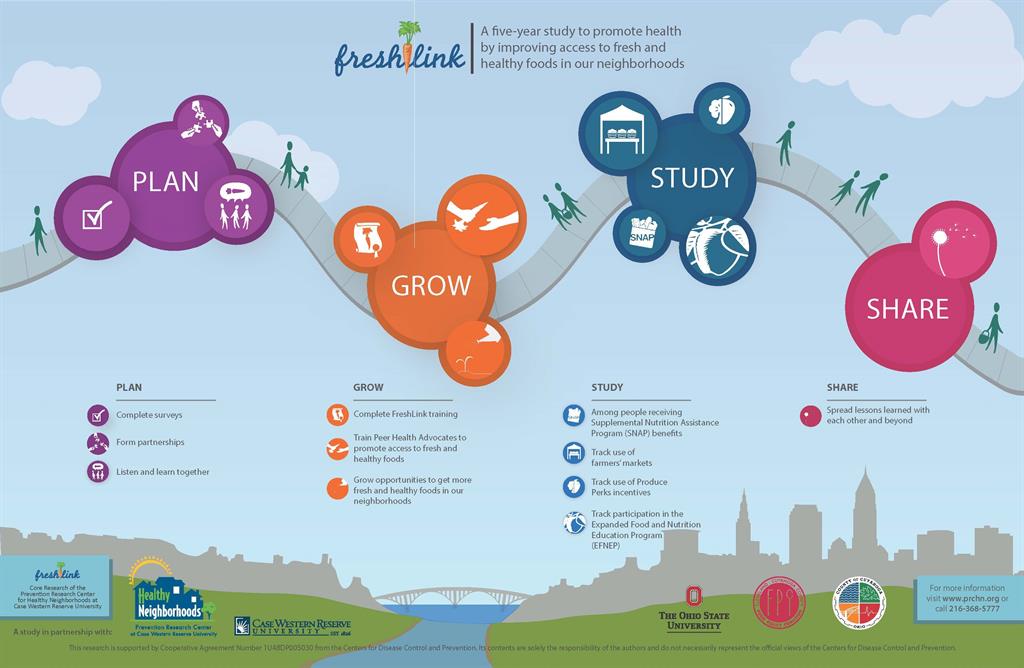
Phase 1: Survey
During summer 2015, FreshLink conducted its first research: a survey of 320 SNAP recipients across low-resource neighborhoods in Cleveland and East Cleveland who have access to a farmers’ market (FM). The survey results formed the basis for much of FreshLink’s work throughout the grant cycle. FreshLink staff conducted on-site recruitment at community-based organizations and farmers’ markets to identify individuals to participate in the survey.
Inclusion criteria for survey participation included
- Currently a SNAP recipient (has an EBT/Ohio Direction Card)
- Resides within one mile of a farmers’ market (FM); each selected FM as a centroid must have at least one census tract with high SNAP participation
- Have child(ren) under 18 years of age living in the home with them at least half of the time
- English or Spanish speaking
- At least 18 years of age
Research Questions for FreshLink Survey, Year 1
- How are SNAP (food stamp) recipients living near an urban farmers’ market similar and different in terms of their beliefs, behaviors, and constraints related to farmers’ market use?
- What are individual, market, and community-level factors that influence whether or not SNAP recipients shop at farmers’ markets? How can these factors be leveraged to motivate these residents to more frequently use farmers’ markets as healthy food retail venues?
- What are the key channels by which SNAP recipients get information about farmers’ markets, Double Value Produce Perks, and nutrition education classes?
In the map below, the blue line outlines the areas of Cleveland and East Cleveland where participants reside.

Phase 2: Food Habits Study
FreshLink conducted in-depth interviews with 30 community residents who previously took the FreshLink survey to learn even more about their social networks around food and food-related habits, such as how they make decisions around purchasing and preparing food and what to eat.

Phase 3: Freshlink Ambassadors
TheFreshLink team tested the effectiveness of a community ambassador model to increase awareness of and connect residents with local resources. The specific goal was to increase access for low-income neighborhoods to nutritious food, specifically at local farmers’ markets. This phase of the project recruited community leaders and hired them as FreshLink Ambassadors to work with the FreshLink team at the PRCHN. With the vision of the program to “bridge residents to resources to foster healthy communities,” we worked to educate residents about local programs such as Produce Perks, and support the local food economy in Cleveland.
PILOT – Year 2
Using feedback from community members via surveys and what was learned through the Food Habits Study, the pilot began in Year Two of the PRC Grant Cycle. Specifically, the pilot tested the original FreshLink Ambassador model at one local farmers’ market during Summer 2016 (Gateway 105 Farmers Market).
INTERVENTION IMPLEMENTATION – Years 3 & 4
In Year Three (2017) of program implementation, we improved the ambassador model using what we learned from the pilot in 2016. In the summer of 2017, we worked with three different farmers’ markets/farm stands: Gateway 105, Good Earth Farmstand, North Union Farmers’ Market at University Hospitals) and eight ambassadors.
As part of the training program, Ambassadors learned to:
- Make referrals to farmers’ markets and explain use of Produce Perks
- Share information about these programs at local outreach sites including Job and Family Service Sites, food pantries, libraries, rec centers and more.
- Provide a welcoming presence on site at participating farmers’ markets.
 .
. 
Year Four (2018) was the last year of intervention for the FreshLink project before the Dissemination phase. In the summer of 2018, FreshLink worked with six markets in Cleveland, including the three sites from Year Three and added Coit Road Farmers Market, North Union Farmers’ Market at Shaker Square, and The Village Market in Slavic Village. Four FreshLink Ambassadors conducted outreach in Year Four. The FreshLink team used the lessons learned in the first year of implementation to improve the program training, scheduling, planning, and outreach in 2018.
Phase 4: FreshLink Program Dissemination
In the fifth year of this study, FreshLink’s goal was to disseminate the findings of the Ambassador model and provide technical assistance to individuals, organizations, and communities interested in adopting this model within their own context. Learn more about the model and training materials below:
FreshLink Ambassador Model Training Timeline

FreshLink Toolkits
FreshLink Training Presentations
- FreshLink Training Orientation
- FreshLink Training Session 1 (Food Access Jeopardy)
- FreshLink Training Session 3
- FreshLink Training Session 4
- FreshLink Training Session 5
- FreshLink Training Session 7
